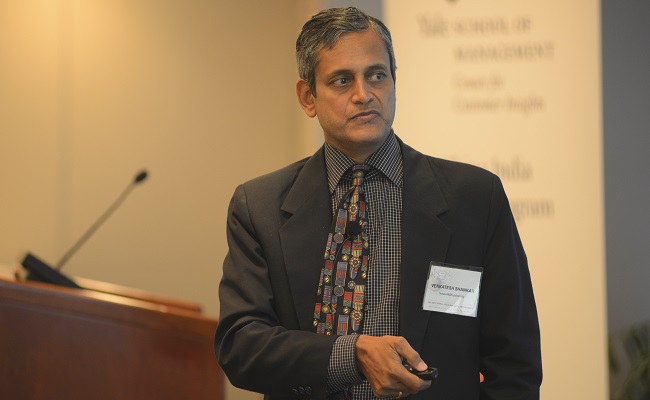Texas A&M’s Venkatesh Shankar on how emerging markets are reshaping the global innovation architecture.
The year 2007 marked a major turning point for General Electric Corporation (GE). For the very first time, in GE’s more than century-old history, the company earned more from its operations outside of the US, than within. That, as the company revealed, was due to strong growth in emerging markets like India and China.
Instances such as this one are forcing Western multinational companies to rethink their strategy to factor in the rise of emerging markets in their growth plans. As a result we are seeing the emergence of interesting new organizational models in multinational companies. While some are looking at emerging markets for revenue growth primarily, others have shifted greater operational control to emerging market subsidiaries. Yet others like GE have gone a step further and are looking at emerging markets as a source of innovation that has application in Western markets as well (a concept that GE CEO Jeffrey Immelt calls ‘reverse innovation’).
According to Venkatesh Shankar, the Coleman Chair Professor in Marketing at Texas A&M’s Mays Business School, emerging markets already contribute 17% to global innovation, and the figure will rise further. He has been studying how emerging markets are reshaping the innovation architecture of global firms. In this interview, he talks about the changes that are kicking in and the challenges that stand in the way. Excerpts:
Q. Over the last few years, we’ve been seeing of the locus of innovation shifting to emerging economies within many multinational companies, such as GE, Philips and Cisco. Who to your mind is an outstanding example of a company that has done this really well?
A. I don’t think there is any company that I would call it an outstanding example. Every company is at a different stage of shifting their innovation architecture. And the companies that you mentioned are there earlier than the others. GE has reaped a lot of benefits of reverse innovation. But if you look at their portfolio of innovation architecture, it will not boast of more than 20% of innovation from the emerging markets. So they are at different stages. I would think that these firms have early experience, and but they’re still learning.
Q. What kind of changes are companies making to their internal structures to factor in emerging markets?
A. There’s already a significant participation of emerging market executives on the boards of multinational companies now. Typically we see multinational companies that are based in the West, headquartered in the West. But we already have a lot of emerging market-based multinational companies that are going aggressively out. India is a prime example. Tata has been more aggressive than the others. Then you have Lenovo and Haier from China. We see more and more emerging market executives on the on the board of companies. Cisco and Microsoft are good examples. Among the leading contenders for the Microsoft CEO job, one or two are probably emerging market people. Emerging market voices are being increasingly heard. So it’s not only that they have a seat at the table, but they have an important role to play. This is a positive development from the point of view of balancing of thinking power, balancing of innovation architecture spread throughout the world.
Q. What are some of the new models that are emerging?
A. If you look at the ways companies are going about embracing emerging markets, including and involving emerging markets in decision-making, there are two ways they are approaching them. One, they’re looking at emerging markets as primarily a source of revenue. So by 2025, 17% of the growth is going to come from emerging markets. That’s a huge number. Two, these markets also become a huge talent pool. That’s also accelerating the way they are placing R&D centers and product development centers, which is also helping emerging markets gain more clout in the decision-making of multinational companies all over the world. Companies are approaching it from both ends: first getting more emerging market executives to be in charge of marketing not only in one emerging market, but lots of emerging markets as well as some developing markets because they have a role to play in the extraction of revenues, but also in the supply of talent. Emerging market executives are becoming more prominent in the headquarters.
The headquarters themselves are not just focused on their one corporate location, but are also spreading over. Halliburton, an oil services company, now has dual headquarters in Houston and Dubai. Even though Houston is the registered office, Dubai is becoming a co-headquarters because the Middle East and the rest of Asia and Russia have become a hotbed of oil exploration. To be able to serve and manage those markets, you need a strong presence. Also, Halliburton has discovered that if they have a co-headquarters, (it) signals a positive commitment and outlook about their intention about emerging markets. So more and more companies like Cisco and Halliburton are going to start treating emerging markets as very significant bases if not the sole headquarters: it could be a co-located headquarters, headquarters for design engineering, headquarters for supply chain. There could be more of this coming in the future.
Q. In many MNCs which come with a long history if you start telling people internally that we need to shift the locus of control more towards emerging markets, it would be hard for them to make the mental shift. What are some of the challenges that come up along the way?
A. That’s a very good point particularly for older companies like GE. If you look at the top management composition and also the age breakdown of the top management of top multinationals, it is skewed heavily toward older people. But if you look at technology companies, the average age of top executives is much lower. In internet-based companies, they are more in the thirties. In non-internet-based technology companies maybe in the forties and fifties, and non-technology companies it’s even sixties in some. In technology and internet-based companies, these executives are embracing it faster. Because they are exposed to this reality, they’re embracing it faster. But in traditional companies, where the average age is much higher, the transition is a bit harder.
One of the things that is also happening is demographic shifts in different emerging markets. India has a huge demographic dividend: 50% of India’s population will be of 25 years and above starting in a few years. When you have India as a very important part of global firms in terms of revenue as well as product development, then these people will have lot more of a role to play and a voice at the table. That would gradually change the age composition of the corporate headquarters too. More and more young people are now getting promoted to top positions even of hundred-year-old firms. So I think it is been harder but it’s going forward. It’s going to be a little bit quicker because if they don’t do that, they won’t be able to compete.
Q. You say that about 17% of global innovation is coming from emerging markets. Is this a good figure by any standard?
A. As we have known, only 17% of multinational companies’ or global companies’ innovation comes from emerging markets, even though (they have) 4.5 billion consuming class. By consuming class I mean anybody with an income of $10 or more out of the global population of 7.5 billion people are in emerging markets. So certainly there’s an imbalance in terms of the home or source of innovation, particularly when they have a talent pool. India has the largest number of engineers graduating and China has definitely the biggest talent pool. If you include Russia, Brazil, South Africa, Turkey, Mexico and all the other emerging markets, then you should see more talent pool at a lower cost, and you should be seeing more innovation coming from those places. But it’s not happening right now because only now firms are embracing these markets for the quality of people and the fact that you can get higher quality at lower prices. We should be looking more towards going from 17% to 40% in the next 10 years or 15 years.
Q. Talking about emerging markets, they themselves are in the state of transition. Ten years back, China was about low cost. Today China’s not like that anymore. How are MNCs taking some of these changes into account?
A. When you look at the evolution of emerging markets, particularly big emerging markets like India, China, Brazil and Russia, at first many of the multinational corporations that are headquartered in the West, treated them as sources for manufacturing, design and customer service. They have lot of talented human-power to do all the jobs. But these markets are growing very fast, and so they have a huge consumption base. Now they are discovering that they can use those products, design and manufacturing to service those local markets. It’s actually a bonus for them because now (they) can have more revenues from these markets.
As they continue to do that, they will discover that the emerging markets have become so big, like China’s luxury market is now poised to overtake the US as the (world’s) largest luxury market. When you have a consuming market there, then you can treat that as a developed market itself. Of course the costs are not going to be anymore cheaper to develop these than it used to be in the past, but then you will identify other emerging markets to shift some of the manufacturing. But it will still not take the focus away from those emerging markets. Car companies are a good example. They initially shift the product design and sometimes manufacturing for lower cost, but then when they see that local markets develop, they start making more products for those markets, for local styles. Those quantities far exceed the quantities that they sell in the developed world. In the next 10 years or so, China may be the biggest auto market. Certainly, right now, it’s selling more cars than in the US and it could still continue to be the case. Soon you would start to see the consolidation of a portfolio of offerings in all these countries where these firms are not only developing low-end models for (those countries), but (also) develop more models, low-end and even high-end. These countries will also be developing those models for nearby markets, depending on the strength of the market. For example, for Hong Kong, Singapore and affluent markets, the development of those products and manufacturing may be going on in China and India. But for the low-end models, it could be going to other countries, low-end countries. Maybe Vietnam could be one of those countries that could be getting those products. Things are already in place, but this takes time to happen and it’s not going to happen suddenly. I think most firms have already realized that.
Q. So you are really saying that we are moving from a situation where emerging markets were typically about the bottom-of-the-pyramid consumer to a multi-tiered situation where maybe the top-end can be common between the developed world and some of these countries where the consumers are becoming rich. There can be variations in the bottom-end which can be more suitable to local environment.
A. Right, and furthermore there’s going to be reverse innovation. Many of these bottom-of-the-pyramid products are going to be exported to even developed markets because there is an increasing income disparity even in developed markets. If you look at poverty in the US today, it’s astounding: 45 million of Americans are really poor and that situation is not going to get any better. So for these 45 million and growing people, there’s going to be a set of products in the future. The top of these markets will look very similar across the developed and emerging, the bottom depending on how many levels you have will look different across this market.
Q. Talking about ‘reverse innovation’, the term suddenly became very fashionable in 2009 when GE CEO Jeffrey Immelt started using it and co-authored a Harvard Business Review article with Vijay Govindarajan and Chris Trimble. But apart from the products that they talked about in the article, there have been very few, isolated examples of reverse innovation actually succeeding across companies. Do you think the uptake of this concept has been slow?
A. That’s a very valid question. One of the chief factors (why uptake is slow is because) firms have to learn how to do this. There’s a learning involved. So you not only have to locate your R&D and product development in an emerging market, but you also have to build particular products for the market and learn from that and then bring the concept to the developed market. The lead time is not very small: we’re looking at five years and more. So if firm started the initiative two years ago, we should see their effectiveness this three years from now. But already we’ve seen this in multiple industries: medical equipment and automobile. We will see a lot of electronics products, computing-based products, that’ll happen more quickly than the others. So there is a huge lead time of learning.
The second reason is to do with the economy and income levels in the developed countries. Right now, the way this is going, we will see the need for these reverse innovations more and more in developed markets. So that should keep that going. But if the developed countries’ economy suddenly improves—it doesn’t look like right now—then the need for the reverse innovation comes down. Right now since it’s not the case, we would expect that reverse innovations would happen more often 5-10 years down the line.
Q. Do developed countries’ MNCs really have the luxury of time because there are also companies in China and India who understand the local market better and are able to quickly react and bring out the products that the market wants. Is five years of lead time actually a good thing?
A. That’s a good question and if we are talking about MNCs based in emerging markets, these companies have a different problem because they don’t have a lot of experience of selling in open and deregulated markets. For them to acquire that experience takes some time. That’s why you see even though developing country MNCs have good brands in local markets, even in adjacent markets, it takes a long learning process for them to get into already developed markets. That is one thing.
The other is they previously lacked the cash resources. Now, thanks to the IPO market being global, they can have more resources to go global quickly. Take Tencent for example. Itis valued at the same market valuation as Facebook, which is incredible. If you have a $200 billion market cap, you can do a lot more things faster as an MNC from an emerging market. If Reliance wanted to do something, it wouldn’t be that easy because they don’t have that kind of financial muscle to expand that quickly. But we will see more of this happening because that capital is available. They can also recruit more people, experienced people from developed company multinationals to roll out. We already see that a lot of MNC CEOs, deputy CEOs are being recruited by these companies .Xiaomi is a great example. They have recruited the top guy from Google. So, these are all pointers to the fact that you can have very quick expansion much more than you’ve seen in the past.




















